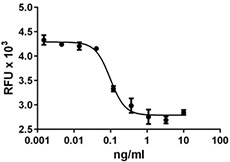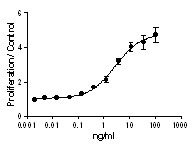- Regulatory Status
- RUO
- Other Names
- IL-12 p80, IL-12 subunit p40, IL-23 subunit p40, Cytotoxic lymphocyte maturation factor, CLMF2, Natural killer cell stimulatory factor 40-KD subunit, NKSF2
- Ave. Rating
- Submit a Review
- Product Citations
- publications

-

Mouse IL-12 p40 homodimer is able to inhibit IL-12-dependent IFNγ production in splenocytes.
| Cat # | Size | Price | Quantity Check Availability | Save | ||
|---|---|---|---|---|---|---|
| 573102 | 10 µg | 165€ | ||||
| 573104 | 25 µg | 306€ | ||||
IL-12 and IL-23 share the p40 subunit, which heterodimerizes respectively with IL-12 p35 or IL-23 p19 subunits to form IL-12 or IL-23. IL-12 p40 exists as a monomer and as a homodimer (IL-12 p80). IL-12 induction is relevant in asthmatic airway inflammation. IL-12 expression can be induced by mouse parainfluenza type I (Sendai) virus and its source is airway epithelial cells. In that experimental model, IL-12 induction is followed by excessive expression of IL-12 p40 that could be further enhanced in IL-12 p35-deficient mice. Overexpression of IL-12 p80 causes macrophage accumulation and contributes to airway inflammation and consequent morbidity during viral bronchitis. Amplified epithelial IL-12 p40 expression and augmented concentrations of BAL fluid IL-12 p40 (but not IL-12 p70) has been detected in asthmatic subjects. It has been demonstrated that p80, but not IL-12 or p40, induces macrophage chemotaxis that is independent of IL-12 and mediated through the cytoplasmic tail of IL-12b1. Additional studies with transgenic mice suggest that overexpression of IL-12 p80 prior to a viral infection increases the number of resident airway macrophages, and this primes the host for a protective response against a lethal respiratory viral infection. In addition, it has been suggested that p80 functions as a competitive antagonist of IL-12 p70. Mouse Con A-activated splenocytes display identical binding affinities for p80 and IL-12, and in these cells p80 competitively inhibited IL-12 binding and IL-12-dependent proliferation. Furthermore, p80 is able to inhibit IL-12-dependent IFNγ production in freshly isolated splenocytes.
Product DetailsProduct Details
- Source
- Mouse IL-12 p40 homodimer, amino acids Met23-Ser335 (Accession # NM_008352), was expressed in insect cells.
- Molecular Mass
- The 313 amino acid recombinant protein has a predicted molecular mass of 35.8 kD. The DTT-reduced protein migrates at approximately 40 kD and the non-reduced protein migrates at approximately 75 kD by SDS-PAGE. The N-terminal amino acid is Met.
- Purity
- >98%, as determined by Coomassie stained SDS-PAGE.
- Formulation
- 0.22 µm filtered protein solution is in 20 mM Tris-HCl, pH 8.0, 0.1 M NaCl
- Endotoxin Level
- Less than 0.01 ng per µg cytokine as determined by the LAL method.
- Concentration
- 10 and 25 µg sizes are bottled at 100 µg/mL. 100 µg size and larger sizes are lot-specific and bottled at the concentration indicated on the vial. To obtain lot-specific concentration and expiration, please enter the lot number in our Certificate of Analysis online tool.
- Storage & Handling
- Unopened vial can be stored between 2°C and 8°C for up to 2 weeks, at -20°C for up to six months, or at -70°C or colder until the expiration date. For maximum results, quick spin vial prior to opening. The protein can be aliquoted and stored at -20°C or colder. Stock solutions can also be prepared at 50 - 100 µg/mL in appropriate sterile buffer, carrier protein such as 0.2 - 1% BSA or HSA can be added when preparing the stock solution. Aliquots can be stored between 2°C and 8°C for up to one week and stored at -20°C or colder for up to 3 months. Avoid repeated freeze/thaw cycles.
- Activity
- ED50 = 1- 4 ng/ml corresponding to a specific activity of 1.0 - 0.25 x 106 units/mg, as determined by the dose dependent inhibition of IL-12-dependent IFNγ production in splenocytes.
- Application
-
Bioassay
- Application Notes
-
BioLegend carrier-free recombinant proteins provided in liquid format are shipped on blue-ice. Our comparison testing data indicates that when handled and stored as recommended, the liquid format has equal or better stability and shelf-life compared to commercially available lyophilized proteins after reconstitution. Our liquid proteins are verified in-house to maintain activity after shipping on blue ice and are backed by our 100% satisfaction guarantee. If you have any concerns, contact us at tech@biolegend.com.
-
Application References
(PubMed link indicates BioLegend citation) -
- Wang X, et al. 1999. Eur. J. Immunol. 29:2007.
- Walter JM, et al. 2001. J. Exp. Med. 193:339.
- Russell TD, et al. 2003. J. Immunol. 171:6866.
- Mikols CL, et al. 2006. Am. J. Respir. Crit. Care 174:461.
- Gunsten S, et al. 2008. Immunology 126:500.
- Jana M, et al. 2009. Glia 57:1553.
- Yabu M, et al. 2010. Int Immunol. 23:29. PubMed
- Product Citations
-
Antigen Details
- Structure
- Homodimer
- Distribution
-
IL-12 p40 homodimer is produced by airway epithelial cells. The expression level of p40 is much higher than that of p35 in IL-12 p70-producing cells; therefore, monocytes, macrophages, neutrophils, dendritic cells, and B cells might express p40 homodimer.
- Function
- p40 homodimer functions as a proinflammatory protein that enhances leukocyte accumulation in the skin, blunt Th1 immunity to Plasmodium berghei, and provides protective immunity toward mycobacterial infection. In addition, p40 homodimer induces macrophage chemotaxis independent of IL-12. Also, IL-12 p40 homodimer (p402) induces the expression of inducible nitric oxide synthase (iNOS) in microglia.
- Interaction
- Airway epithelial cell, macrophages, microglia, and spleenocytes.
- Ligand/Receptor
- IL-12Rβ1
- Biology Area
- Cell Biology, Immunology, Innate Immunity
- Molecular Family
- Cytokines/Chemokines
- Gene ID
- 3593 View all products for this Gene ID
- UniProt
- View information about IL-12 p40 on UniProt.org
Related Pages & Pathways
Pages
Related FAQs
- Why choose BioLegend recombinant proteins?
-
• Each lot of product is quality-tested for bioactivity as indicated on the data sheet.
• Greater than 95% Purity or higher, tested on every lot of product.
• 100% Satisfaction Guarantee for quality performance, stability, and consistency.
• Ready-to-use liquid format saves time and reduces challenges associated with reconstitution.
• Bulk and customization available. Contact us.
• Learn more about our Recombinant Proteins. - How does the activity of your recombinant proteins compare to competitors?
-
We quality control each and every lot of recombinant protein. Not only do we check its bioactivity, but we also compare it against other commercially available recombinant proteins. We make sure each recombinant protein’s activity is at least as good as or better than the competition’s. In order to provide you with the best possible product, we ensure that our testing process is rigorous and thorough. If you’re curious and eager to make the switch to BioLegend recombinants, contact your sales representative today!
- What is the specific activity or ED50 of my recombinant protein?
-
The specific activity range of the protein is indicated on the product datasheets. Because the exact activity values on a per unit basis can largely fluctuate depending on a number of factors, including the nature of the assay, cell density, age of cells/passage number, culture media used, and end user technique, the specific activity is best defined as a range and we guarantee the specific activity of all our lots will be within the range indicated on the datasheet. Please note this only applies to recombinants labeled for use in bioassays. ELISA standard recombinant proteins are not recommended for bioassay usage as they are not tested for these applications.
- Have your recombinants been tested for stability?
-
Our testing shows that the recombinant proteins are able to withstand room temperature for a week without losing activity. In addition the recombinant proteins were also found to withstand four cycles of freeze and thaw without losing activity.
- Does specific activity of a recombinant protein vary between lots?
-
Specific activity will vary for each lot and for the type of experiment that is done to validate it, but all passed lots will have activity within the established ED50 range for the product and we guarantee that our products will have lot-to-lot consistency. Please conduct an experiment-specific validation to find the optimal ED50 for your system.
- How do you convert activity as an ED50 in ng/ml to a specific activity in Units/mg?
-
Use formula Specific activity (Units/mg) = 10^6/ ED50 (ng/mL)
 Login / Register
Login / Register 














Follow Us